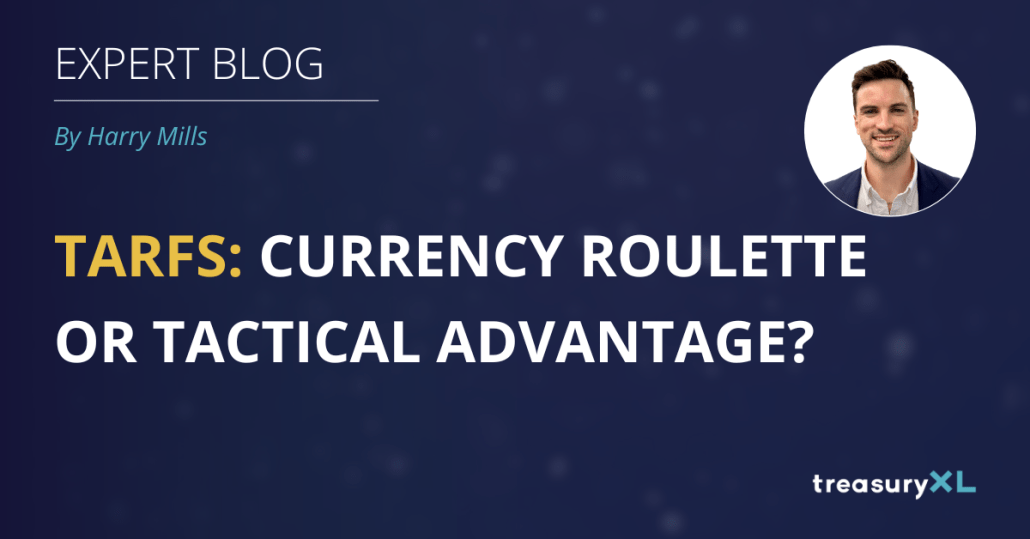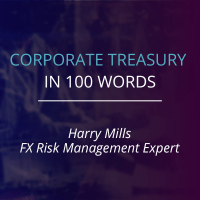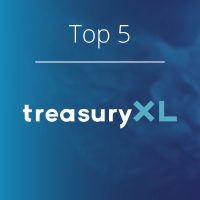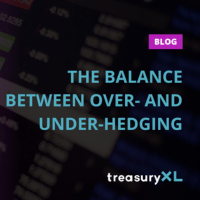TARFs offer enhanced FX rates by combining forwards and options, but at the cost of leverage and potential losses. This article by treasuryXL expert Harry Mills explains how they work, their benefits, and their risks.
No Free Lunch
Have you ever been offered a better-than-market exchange rate for a currency contract? ‘What sorcery is this?’ you might be asking, but it’s absolutely possible, and like everything in life, there’s no such thing as a free lunch.
So, how do you achieve these better-than-market rates? Enter leveraged options. Let’s cover some important background to bring you up to speed – if you’re comfortable with Options basics, you can skip ahead to ‘What is a TARF’:
What is an Option?
An Option is a type of financial instrument that gives its buyer the right to buy or sell one currency in exchange for another at an agreed rate on a set future date. If, come the contract’s expiry date, the market rate is more favourable than the option’s “strike” rate (the contract/hedging rate), the buyer of the option allows the contract to expire worthless and can trade at the better spot rate if they wish. This choice, rather than a compulsion to exchange, is commonly described as having “the right but not the obligation”, and it comes with a cost: To buy an option, an up-front premium is payable to the option’s seller.
– A Call option gives the buyer the right to buy the underlying
– A Put option gives the buyer the right to sell the underlying
In FX, we use the currency pair’s base currency to determine the cash flow direction. This would be ‘GBP’ in “GBP/USD”; meaning, we refer to a Put as a GBP Put, and a Call as a GBP Call. See below:
| GBP/USD Example | Option Type | Your Cash Flow |
| You Buy… | A Call Option | Buy GBP and Sell USD |
| A Put Option | Sell GBP and Buy USD | |
| You Sell… | A Call Option | Sell GBP and Buy USD |
| A Put Option | Buy GBP and Sell USD |
Buying and Selling Options:
If you buy a call and sell a put (or vice versa), both with the same strike rate, expiry date, and notional amount, you’ve created a synthetic forward contract. The strike rate that results in a net premium of zero will match the market forward rate!
- Buy Call + Sell Put = Synthetic long forward (Buy the base CCY)
- Sell Call + Buy Put = Synthetic short forward (Sell the base CCY)
But what if you adjust the notional amounts?
Let’s look at three simple two-leg option structures from the perspective of a UK exporter looking to convert USD 100K income back to GBP, all with the same strike rate at the market forward rate:
| Buy GBP Call | Sell GBP Put | What is it? | Net Premium | For Zero Premium |
| $100,000 | $50,000 | Participating Forward | Net Pay | Make strikes worse |
| $100,000 | $100,000 | Synthetic Forward | Net Zero | No change |
| $50,000 | $100,000 | Ratio Forward | Net Receive | Make strikes better |
- The participating forward gives the exporter the right to sell $100K at the forward rate, protecting them from a weakening dollar, and introducing an obligation to sell $50K if the market rate finishes below the strike rate at expiry. This means they can “participate” in 50% of any favourable market movements in case the dollar strengthens by the expiry date. This product requires a premium to be paid unless the strike rate is set less favourably enough to produce a zero-premium contract. This is considered a low-risk product.
- The ratio forward is, from a protection: obligation perspective, the inverse of the participating forward, and it gives the exporter the right to sell $50K at the forward rate, partially protecting them from a weakening dollar, and introducing an obligation to sell $100K if the market rate finishes below the strike rate at expiry. This means they don’t participate in any favourable market movements in case the dollar strengthens by the expiry date, and they maintain 50% of the risk of a weakening dollar. In return, the structure produces a net credit of premium, which can fund an improved hedging rate. This is considered a higher-risk product, and it’s where the better-than-market rates come in.
You can see that, in the case of the Ratio Forward, by selling more than they are buying, the exporter faces either under-hedging or over-hedging risk. If the trade is structured as $50K:$100K then the exporter could be under-hedged by $50K. If the trade is structured as $100K:$200K, then the exporter could be over-hedged by $100K.
We call any product or structure that sells more options than it buys as “leveraged”. And as you can figure from the concept of over- or under-hedging risk, this is how, with better-than-market exchange rates, there’s no free lunch!
What is a TARF?
TARF stands for Target Redemption Forward; a sophisticated, structured FX product combining options and forwards to offer enhanced exchange rates over a series of future settlement dates.
The concept of “target redemption” originated in the world of structured notes (debt securities), specifically, TARNs (Target Redemption Notes). These are fixed-income products that pay out coupons until a pre-agreed cumulative return is hit, at which point the note redeems early. TARFs borrow this idea and apply it to currency transactions.
In a TARF, instead of coupon payments, the “target” is a cumulative gain, or “profit target”, from a series of FX fixings. Once the target is hit, the contract terminates, potentially leaving its buyer, the hedger, unhedged for the remaining period.
The “profit target” is the maximum benefit that the TARF can pay out to its buyer before the contract is fully redeemed and is terminated. It is usually expressed in terms of the exchange rate – the number of pips, big figures, or cents – but it can also just as easily be expressed as an amount.
An important characteristic of TARFs is that they are short volatility products. By entering into a TARF, the hedger is effectively selling volatility to the bank, accepting limited upside (via the capped profit target) in exchange for enhanced rates, while taking on the risk of adverse market moves. If the market becomes volatile and moves significantly against the hedger, the TARF’s leveraged obligations can lead to substantial losses. In this way, the TARF buyer is giving up the benefits of market swings in return for a fixed, front-loaded advantage.
This short-volatility profile means TARFs tend to perform best in stable or trending markets, where the spot rate moves gradually and without bouts of sharp directional movements. Most TARF buyers would prefer the product to terminate after just a few favourable fixings, allowing them to lock in the enhanced rate, capture the full benefit, and avoid the risk of future adverse market moves. Once the target is hit and the contract is redeemed, many simply rebook another TARF or explore a new trade idea that reflects their updated market view. In this way, TARFs can become part of a rolling strategy, but one that requires discipline, oversight, careful management and a clear understanding of the risks involved. To be clear, TARFs can produce significant out-performance against the spot rate, but this is not without substantial risk.
But in volatile or whipsawing markets, the risk of adverse fixings increases, especially when leverage is involved. Each OTM fixing doesn’t just delay redemption; it can multiply the hedger’s exposure, particularly if the structure includes 2x (or more) leverage. TARFs tend to be long-dated contracts, so the risk of the hedger being obligated at adverse rates for a prolonged period is significant, however the termination feature means that once the profit target is redeemed, all future obligations cease to exist – in this way, the TARF arguably has an advantage over other enhanced rate structures which may contain a strip of knock-out forwards, for example, which represent a contingent liability for possibly up to 24 months or longer. It’s also worth noting that TARFs are path-dependent, meaning the outcome depends not just on where the exchange rate ends up, but how it gets there. A spot rate that oscillates around the strike can lead to a string of OTM fixings, increasing the hedger’s obligations without reducing the profit target.
Let’s look at an example to see how it works. Let’s assume the GBPUSD spot rate is $1.3300.
| CCY Pair | GBP/USD |
| Direction | Sell GBP to buy USD |
| Strike Rate | 1.4000 |
| # Fixings | 18 (monthly, from next month) |
| Notional Amount | GBP 100,000 (In The Money Fixings) |
| Leveraged Amount | GBP 200,000 (Out of The Money Fixings) |
| Profit Target | 0.1500 (15 big figures, 1500 pips) |
At each fixing, the Strike Rate is either:
- More favourable than the spot rate (i.e., in this example, strike rate > spot*), meaning the fixing is In The Money (ITM); or
- Equal or less favourable than the spot rate (i.e., in this example, spot > strike rate*), meaning the fixing is Out of The Money (OTM).
*If the trade direction was opposite – sell USD to buy GBP – a lower rate would be more favourable.
If the fixing is ITM, the buyer of the TARF sells GBP 100,000 at 1.4000, and the Profit Target is reduced by the difference between the Strike Rate and the spot rate. So, let’s say spot is at 1.3500 – the profit target reduces from 0.1500 to 0.1000 and is carried forward to the next fixing date. If the profit target is insufficient to cover the distance between the Strike Rate and the spot rate, then the TARF buyer usually receives an adjusted payout– either the full notional amount at an adjusted strike rate, or an adjusted amount at the contract strike rate – this is a matter of preference, as the payout is the same.
If, on the other hand, the fixing is OTM, the buyer of the TARF sells GBP 200,000 at 1.4000, and the Profit Target is unchanged. So, let’s say spot is at 1.4500 – the hedger is obligated to transact the leveraged amount of GBP 200K at 1.4000, 5-cents below the spot rate!
Looking at the profit target of 1500 pips from the example, we can see that the contract would be fully redeemed on the first fixing if the spot rate fell to 1.2500 or below (1.40 – 0.15 = 1.25). This is obviously an extreme example, but it’s worth understanding. The maximum benefit of the contract in dollar terms is simply GBP 100,000 * 0.1500 = USD 15,000.
TARFs have a known maximum possible gain, but what about the potential losses?
Possible losses are unknown and uncapped, but how so? Using our example, if the spot rate rises and keeps going, the buyer of our example TARF would be obligated to sell GBP 200,000 each month at 1.4000, which represents an unfavourable outcome and mark-to-market losses vs spot.
Of course, if the TARF buyer would otherwise have booked an 18-month forward contract at $1.33 anyway, this mightn’t be a bad outcome, but if this weren’t the case, they would have had to accept significant downside risk by entering the TARF. There’s no free lunch, remember!
Finally, this example showed a Vanilla TARF with 1:2 (2x) leverage – TARFs can be booked with or without leverage, and there are a host of variants available in the market, including but not limited to:
- Knock-In TARF: Offers a degree of participation until a trigger level is reached; once the market touches or breaches the knock-in level, the structure becomes active, often increasing the hedger’s obligations or exposure.
- Variable Strike (or Notional) TARF: The TARF can be structured so that either the strike rate and/or the notional amount is variable per fixing date; this allows for more dynamic risk/reward profiles, often used to tailor the structure to specific market views or hedging needs, but caution should be exercised when front-loading benefit for back-loaded OTM pain.
- Collar TARF: Uses upper and lower strike levels to define a band of outcomes; the hedger benefits within the range but is limited outside it, offering more predictable cash flows. • Pivot TARF: Introduces a central “pivot” level where the payout profile changes depending on whether the market finishes above or below that level on each fixing date; often used to create asymmetric payoff profiles.
These variations allow for a wide range of risk-return profiles, but they all share the same DNA: enhanced rates in exchange for conditional obligations and a (spot price) path-dependent payoff. And as always, the more attractive the headline rate/terms, the more important it is to understand the risk of an unfavourable outcome.
TARFs have made headlines in recent years, and not always for the right reasons. One of the most notable cases involved a European engineering firm that entered into a series of EUR/USD TARFs to hedge incoming dollar revenues. When the euro weakened sharply, the company found itself overexposed due to the leveraged nature of the contracts, facing obligations far beyond its operational cash flows. The resulting losses were so severe that the company filed for a corporate debt restructuring process to preserve business continuity. This case, and others like it, serve as a cautionary tale: while TARFs can offer attractive rates and short-term gains, they must be handled with care, robust risk management, and a clear understanding of the downside. As ever, there’s no free lunch.

Harry Mills, Founder at Oku Markets










